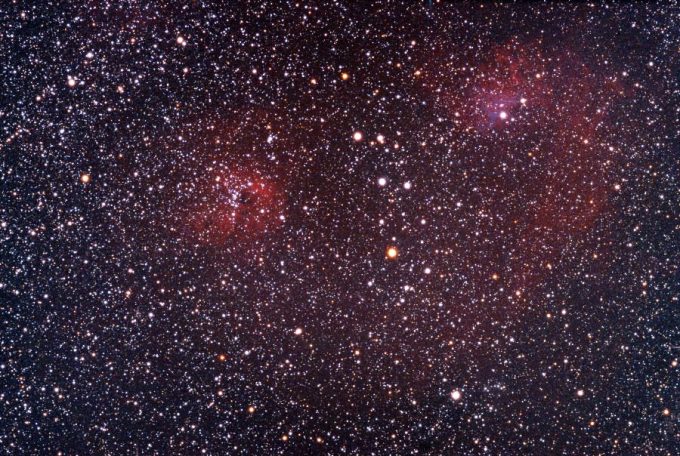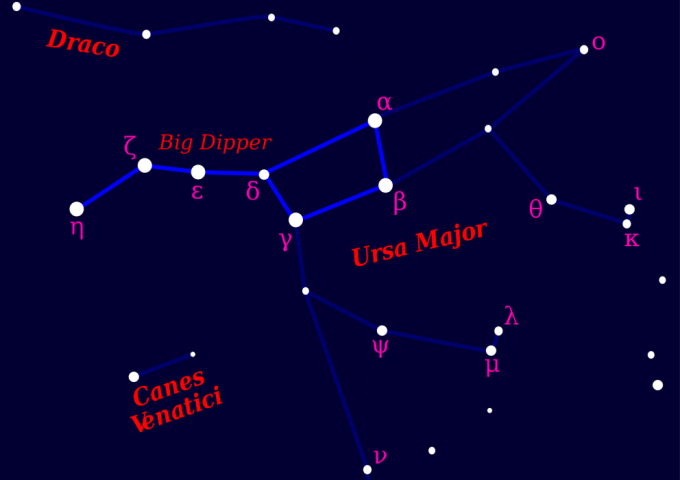How to Navigate by the Stars: the Ultimate Celestial Guide
Being guided by the stars: sounds romantic, doesn’t it? Imagine it’s night time; it’s quiet, away from noise and light pollution, just you and nature. Walking the quiet countryside at night and only relying on the stars is an experience everybody should try at some point in their lives.
But, navigating by the stars is a daunting thing to think about. Maybe it sounds like something way beyond your orientation skills; you feel like you’ll never be outdoor savvy enough to actually find your way home with just the stars!
This is exactly why we have decided to create this handy step by step guide about how to navigate by the stars. It’s so much easier than you think! Whether you’re in the Northern or Southern Hemisphere, we will be telling you how to find north, south, east and west and will be letting you in on some extra handy tricks about finding your direction using star movements.
You’ll be wandering the countryside without any navigation equipment in no time.
GPS and Compasses, Be Gone!
Before the compass, and way before the maps feature on your smartphone, the only means of finding your direction was through celestial navigation. For thousands of years, people used only the stars for their adventures.

Maybe GPS makes things a little easier for us, but learning how to navigate by the stars is certainly a handy thing to know if you’re a keen explorer. By learning just a few stars and their constellations you’ll be able to find different directions and, if you want to, you can also figure out your latitude with just a star and your hand!
Does Star Navigation Work?
“But using the stars doesn’t seem reliable” – nonsense! Your phone could run out of battery, your compass could break; you could lose all your belongings to a curious bear. Navigation by the stars is the most reliable and constant navigation tool you have and, once you know how to read them, they are super easy to read and follow.
Stars act as our guideposts, rising from a fixed location and setting in the same place, the only change being that they rise around 4 minutes later each night. Depending on whether you’re in the Northern or Southern hemisphere, you’ll be able to find certain stars and constellations that remain constant in the sky, telling you exactly what direction you’re heading in.
(You can also pick any particular star in the sky and follow its movements to work out where you are and what direction you’re facing. Neat, right?)

So, you’re all excited to find out exactly what you need to do so you can go on your starry trip. Well, it all begins with preparation…
Prepare for a Star Navigation Trip
There are several things you need to think about before you go on your night-time adventure, from being aware of the weather to ensuring you’re in the right place. It is always smart to do a little bit of prep, we recommend to…
Check The Weather For Clear Skies
If you’re going out on a stormy, cloudy night you may have a hard time seeing any stars, let alone navigating by them. Try and plan your trip when there’s little to no cloud cover.
Pack Аccordingly
Whether you’re a seasoned hiker or new to outdoor adventure, it’s important to ensure you pack accordingly. Clear skies can mean colder nights so, if you’re wandering around outdoors at night following the stars, make sure you’re wrapped up properly and have all the right equipment for your trip!
Escape Light Pollution
Get yourself away from the bright lights of the city and into the quiet of the countryside. You’ll be far from light pollution as to see the stars much more clearly. A bonus of this is that you get to see the beauty of the night sky so much better!

This is by no means a must, but going during a waning moon is also a great idea, as the less moonlight you have, the better chance you have of seeing the stars clearly. If you go during a crescent moon, you can use this for navigation, too!
Have a Backup Plan
Now, this all depends on whether you’re throwing yourself fully into survival mode or not. If you really want to test yourself, leave the smartphone and compass at home. But, if you’re just testing the waters and flexing your natural orientation skills then we recommend you pack some backup equipment, just in case you get lost and surprise storm clouds end up coming your way.
Be Aware Of Where You Are: Northern or Southern Hemisphere
The techniques of star navigation differ from Northern to Southern Hemisphere, so make sure you are looking for the correct constellations and know what they’re telling you according to where you are. Luckily, we’ve got you covered! We have both a Northern Hemisphere navigation guide and a Southern Hemisphere navigation guide.
Why Different Guides For Different Hemispheres?
The area of sky we can see at night all depends on our latitude. This is how far north or south of the equator we are. What we can see also depends on the Earth’s position in space; the position of the stars changes throughout the year.

Places at the same latitude see the same view of the night sky, but people living on the same longitude are often be looking at completely different skies and constellations! Places too far north can’t see objects like the South Celestial Pole and constellations like the Southern Cross. Similarly, places too far south can’t see things like Polaris, the North Star.
Orientation in the Northern Hemisphere
Let’s get started with our celestial navigating in the Northern Hemisphere…
Find North with Polaris
Polaris, also known as the North Star, is the ideal way of orienting yourself if you’re in the Northern Hemisphere. Resting within a degree of the North Pole, this star is a more accurate measurement of direction than most compasses!
The North Star always remains at the same spot, above the North Pole, which is why we use it in star navigation. Think of it as a central point, unmoving, with all the other stars rotating around it. So, find The North Star in the sky and you will know where true North is.
The North Star is not, in fact, the brightest star in the entire sky. That’s just a myth! But don’t worry;the North Star star is still the brightest in its piece of sky and in its constellation Ursa Minor, also known as the Little Bear, also known as the Little Dipper (so many names!).
Look for the Plough or the Big Dipper
Using the easy-to-spot constellations around The North Star, you’ll find it easily!

The Plough, also known as the Big Dipper, is an easily identifiable constellation of seven stars in the shape of a saucepan. You guessed it; the Saucepan is another name for it, too. The Plough rotates anti-clockwise around the North Star, and so does often appear sideways or upside-down.
- Look for the pointer stars of the Plough, Merak and Dubh, which form the blade of this constellation
- These two stars form a straight line with the North Star
- The North Star will always be around five times the distance between these two stars in the direction they point away from the Plough.
Can’t find the Plough? Look for Cassiopeia instead!
Almost opposite the Plough is the constellation Cassiopeia. If the Plough is too low or obscured, you can also find the North Star with this constellation, which sits high in the sky. With its five moderately bright stars, Cassiopeia resembles a W or M shape. If you draw a line bisecting the first valley of the W, this line will point towards the North Star.
The North Star is found around halfway between the Plough and Cassiopeia.
Check If You Have the North Star
Checking you’ve got the right star is easy. The North Star is part of the Little Dipper, which is composed of seven stars: three as the handle and four as the head of the spoon. The North Star is the last star in the handle of the Little Dipper.
Find Your Latitude with the North Star
When you are in the Northern Hemisphere, the North Star is at the same angle above the horizon as your latitude. You can accurately measure this with a sextant, but you can also estimate your latitude using just your outstretched fist!

All you need to do is extend your fist to the horizon, and then stack fist-over-fist until you reach the North Star. One extended fist is approximately 10 degrees.
Find South with Orion
Orion, the Hunter, looks a little like a bent hourglass. The stars Betelgeuse and Bellatrix are its shoulders; Saiph and Rigel represent its knees and the three middle stars in, Alnitak, Alnilam, and Mintaka, are Orion’s belt.
- To find south you first need to find Orion’s belt
- Then, look for three vertical stars – one bright, one dim, and one fuzzy – below the belt
- These three stars point close to due south
- Using the Sword to find south is most reliable when it is near vertical
In the northern hemisphere, Orion is best seen in the winter and early spring, but can also be found before a summer sunrise or late at night in the fall.
Southern Hemisphere
If you’re south of the equator, you’re not likely to see the North Star and therefore finding north can be tricky! But don’t worry, it’s pretty easy to find south, instead! Here’s all you need to know about star navigation in the Southern Hemisphere…
Finding South with Crux
There is a star near the South Pole, Sigma Octantis, however this star is too dim to help you find south. Instead, to find south, look for Crux, also known as the Southern Cross. This constellation consists of four compact stars which form the ends of the cross.

The orientation and position of the Southern Cross is constantly changing. It appears to rotate around a point in the sky known as the South Celestial Pole. This means that during the night, the orientation of this constellation changes from upright, to sideways, to upside-down. Its position and orientation also change over the course of a year.
Fun fact: The Southern Cross is such a prominent and visible constellation that it’s shown on the Australian flag!
Once you’ve found the characteristic four stars that form the Southern Cross, there are two different ways to find south:
Method one
- Let’s start by finding the two stars at the head and foot of the Southern Cross
- Now, join these two with a line and extend this line out
- You’ll want to extend the line out to four and a half times
- Woohoo! You are now at the South Celestial Pole – the other stars in the sky rotate around this point
- Last step: just look down from the South Celestial Pole right to the horizon. You now know where south is!
Method two
This method is a little trickier, but it is also a little more accurate than method one. This method involves using both the Southern Cross and two pointer stars from the neighboring constellation, Centaurus.
- First, you will need to find the two bright pointer stars, Alpha Centauri and Beta Centauri, which are located close to the Southern Cross
- Draw a line between these two stars
- Then, take another line perpendicular to the middle of the first line
- Extend this perpendicular line until it intersects with the line drawn from the head and foot of the Southern Cross
- The intersection of these two lines is the South Celestial Pole. From here, just drop a line straight down to the horizon. You’ve found south again!
Both Hemispheres and the Celestial Equator
There are a few ways to find direction without using the North Star or the Southern Cross! This is perfect for those living on the equator or in either hemisphere wanting to test their navigation skills even more!
Finding East and West with Orion
Find the constellation Orion. As noted above, in the Northern Hemisphere guide, the torso of the constellation looks akin to a bent hourglass. Orion rises in the east and sets in the west. Orion’s belt, the three bright stars that form a short straight line, rises very close to due east and sets equally as close to due west wherever you are in the world.

If you want to be super accurate the rightmost star in Orion’s belt, Mintaka, is exactly what you need! This star rises within one degree of true east and sets within a degree of true west.
Celestial Movements
In the nighttime, stars will always rise in the east and set in the west, just like the sun and moon. This is due to the Earth spinning from west to east; everything in the sky comes into view as we spin towards it and then leaves our view as we’respinning away from it.
Fun fact: Not all stars rise and set. This is dependent on where you are! Some stars go around the sky in a circular motion around their celestial pole.
Find Your Direction by Following Star Movements
If you’re disoriented, you can find your direction by following the star’s movements. All you need is a stick, or two!

The stick and star technique:
- Pop two sticks into the ground, spaced about one meter
- Choose a star (go for a bright one!)
- Line it up with the tops of the sticks
- Now, allow the star to misalign with the sticks (give it at least ten minutes)
- The direction your star moves tells you where you’re facing
- Left: North
- Right: South
- Upwards: East
- Downwards: West
Using the Crescent Moon To Navigate
Yes, we know that the moon isn’t a star. But, though less reliable than the star techniques above, you can still use the crescent moon to navigate. This is handy information for those wanting to know everything celestial navigation-related!
This method only works when the moon is in its waxing crescent or waning crescent phases. These phases occur around seven days in a calendar month and typically happen at the beginning and end of the month.

Depending on what hemisphere you’re located in, the crescent moon will help you identify either south or north and here’s how:
- Find the crescent moon
- Draw a line between the crescent’s points
- Now, track this line to the horizon
Northern Hemisphere folks, the line you’re looking at is pointing south, Southern Hemisphere explorers, the line you’re looking at is pointing north. And, good to know, if the moon rises before sunset, the bright side of the moon will be facing west. After midnight, it will be facing east!
It’s Time to Explore Using the Stars!
So there you have it: a guide to celestial navigation, wherever you are in the world. Whether you’re lost at the woods, wandering the desert, or just testing your star-reading skills, you now have the know-how about how to find north, south, east and west. You should also be able to work out what direction you’re facing by tracking the movements of the stars, and you’ll even know how to use the crescent moon to navigate!
We bet you can’t wait to get started! Just don’t forget about the necessity for clear skies and following the correct instructions for wherever you are.





